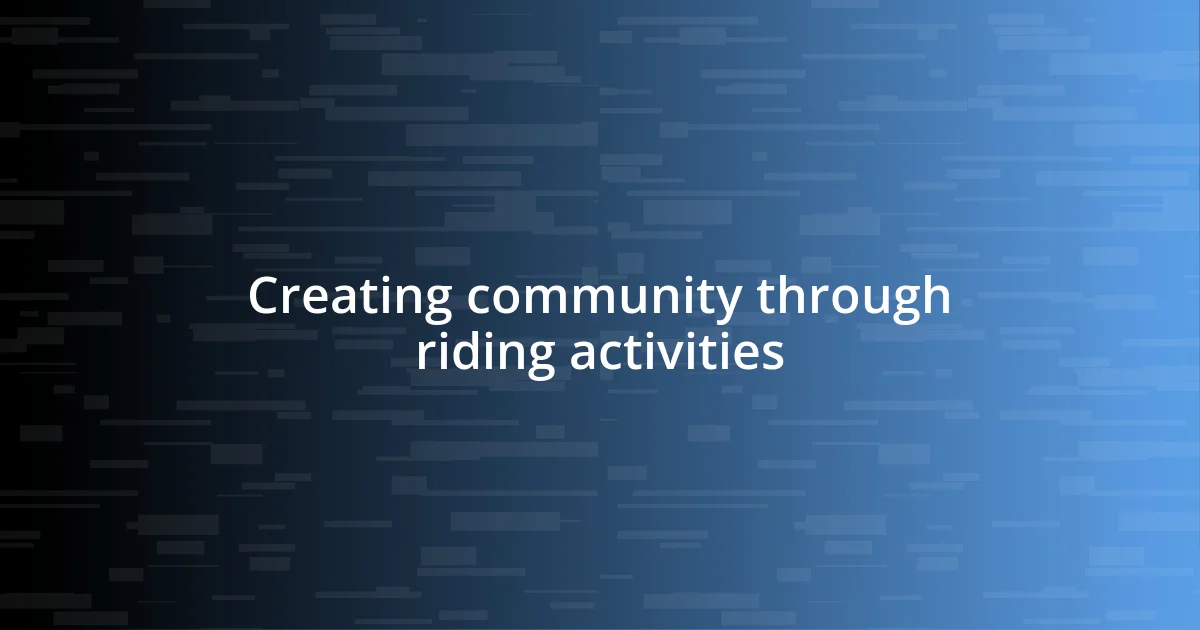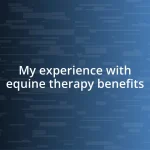Key takeaways:
- Emotional resilience involves facing pain and learning from it, making it essential to cultivate coping strategies over time.
- Riding enhances confidence through skill development, overcoming fears, achieving goals, and fostering a connection with nature.
- Group riding activities create a sense of community, strengthening bonds among riders and enhancing support networks through shared experiences.

Understanding emotional resilience
Emotional resilience refers to the ability to recover from setbacks and maintain emotional balance during challenging times. It’s like having an internal toolkit filled with coping strategies that help you navigate life’s ups and downs. Have you ever noticed how some people seem to bounce back from adversity more easily than others? That’s resilience at work.
I remember a time when I faced a significant personal loss. It was a challenging period, and I had to dig deep to find my emotional footing. During that time, I discovered that resilience isn’t about avoiding pain; it involves facing it head-on and learning from it. This experience taught me that our emotional responses play a crucial role in shaping our resilience.
Understanding emotional resilience also means recognizing that it can be cultivated over time. Just like building muscle, it requires practice and intention. Have you ever thought about what makes you feel strong in difficult moments? I’ve found that connecting with supportive people and engaging in self-care activities can help fortify my resilience. Each struggle we face can serve as an opportunity to grow, making us more equipped to handle future challenges.

Building confidence through riding experiences
I’ve observed that riding can be a powerful way to boost confidence, often transforming nervousness into self-assuredness. When I first climbed onto the saddle, I felt a mix of excitement and fear, unsure if I could really control the horse beneath me. However, with each ride, I learned to communicate better with the horse, gaining trust in my abilities. Each small achievement, like mastering a trot or safely navigating a tricky route, built a sense of accomplishment that extended beyond the stable.
Here are a few ways riding fosters confidence:
- Skill Development: As you learn to ride, your competence increases, reinforcing belief in your abilities.
- Overcoming Fear: Tackling challenges in riding directly confronts your fears, proving to yourself that you can face difficult situations.
- Goal Achievement: Setting and reaching riding-related goals fosters a sense of success, enhancing your self-esteem.
- Connection with Nature: The bond with a horse can boost your confidence, as you realize you are working in harmony with a powerful animal.

Developing coping mechanisms via riding
Riding offers a unique environment where individuals can develop effective coping mechanisms. The rhythmic movement and connection with the horse create a calming atmosphere that allows me to process emotions more clearly. I remember feeling overwhelmed after a tough week, but once on horseback, the gentle swaying and the horse breathing beneath me soothed my anxiety, providing a moment of escape and reflection.
When facing challenges, the skills learned from riding translate into my everyday life. Each time I encounter a difficult riding scenario, I am pushed to think critically and adapt. For example, the first time I tried to ride over a jump, I was nervous, but I learned to focus on my breath and maintain my balance. That experience instilled a sense of patience and resilience, which I’ve carried into my personal challenges. The ability to stay calm under pressure is a powerful coping mechanism that has enhanced my overall emotional resilience.
Moreover, riding teaches the importance of connection and communication—not just with the horse, but with oneself. During moments of tension, I’ve learned to check in with my feelings and adjust my approach, much like how I adjust my cues to the horse. This feedback loop fosters self-awareness, a crucial element in developing effective coping strategies. It’s remarkable how beneficial a simple ride can be in refining my emotional toolkit.
| Coping Mechanism | Riding Experience Example |
|---|---|
| Mindfulness | The rhythmic movement helps focus on the present moment, reducing anxiety. |
| Problem-Solving | Adapting strategies while riding reinforces critical thinking in challenging situations. |
| Emotional Awareness | Connecting with the horse encourages introspection and understanding of feelings. |

Creating community through riding activities
Participating in group riding activities has a remarkable way of fostering a sense of community among riders. I recall the time my local riding club organized a weekend trail ride; bonded over shared experiences and challenges, we laughed and encouraged one another. There’s something uniquely uplifting about working together to conquer muddy paths or navigate steep hillsides, and I find that this camaraderie creates an environment where friendships can flourish.
Additionally, the shared love for horses and riding acts as a strong unifying force. During a recent equestrian event, I noticed how riders of all ages came together to cheer for each other, celebrating each successful jump or gallop. I was touched by how strangers became friends simply by sharing their passion for riding. This collective enthusiasm not only enhances the riding experience but also cultivates a supportive network where everyone feels valued.
Creating community through riding activities can also extend beyond the saddle. I remember hosting a potluck for fellow riders, where we exchanged stories about our horses and shared our riding journeys. Those evenings were filled with laughter and emotions, deepening our connections long after the horses were put away. Have you ever felt that sense of belonging just because you share an interest? It’s truly fulfilling to be part of a community that understands and appreciates our mutual passion.














